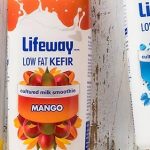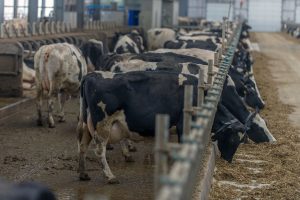
European farmers often appear locked in a battle with regulation. Neal Wallace meets a Dutch dairy farmer who says while there are too many rules, there are also benefits.
Netherlands dairy farmers Coen and Marieke Wantenaar may just provide a glimpse into how dairy farming could evolve.
The third-generation farmers started farming Wantenaardig Dairy, an 82 hectare property, in 2021 and today run 150 cows and 70 young stock at Soest near Utrecht.
At any one time they milk about 110 cows three times a day, all year round, producing about 11,000 litres/cow/pa. The milk goes to the FrieslandCampina co-operative.
Provided they meet certain quality, management and environmental criteria, they receive a premium over the base price, currently around 50c/litre, which is worth an extra 3.5c/litre to them.
Being fully compliant is worth 5c/litre, something the Wantenaars are working towards. The organic premium is between 10c and 12c/litre more.
Coen Wantenaar estimates his cost of production is about 45c/litre, a bit higher than he would like.
He said securing milk premiums is key to his business, and the data and information he collects to comply provides him with an additional insight into his operation.
The premiums are weighted against animal welfare, climate, biodiversity and grazing metrics.
They must meet standards and thresholds such as the age of herd, calf-rearing practices, greenhouse gas emissions, nitrogen-soil balance, ammonia emissions, permanent grassland, nature and landscape and grazing management.
One premium they earn is by supplying a fresh milk label, Planet Proof, available to farms that keep their cows outside for 16 hours a day, 120 days a year along with meeting criteria for carbon emissions and nutrient management.
He recently built a pond to comply with the nature requirements, and in it he has planted herbs and native shrubs.
Support and reward achieves higher levels of compliance than a stick approach.
“I feel this is a good way to reward good behaviour,” Coen said.
Premiums offered by his milk co-operative will only become a bigger part of his business.
“This will only be more in the future because this all they talk about at the moment.”

The Netherlands is criss-crossed with drains and waterways and there is a push to have sloping instead of right-angle banks as these are friendlier to wildlife.
He said there is too much regulation, but feed advisers and vets are crucial to helping him meet those regulations and milk company standards.
Because they are on the farm regularly, advisers have an intimidate understanding and contribute to his business, for example by sampling pasture and maize and, along with manure samples, providing data on diets, which contributes to refining his stock feed recipe.
In addition to bonus milk payments, the Wantenaars receives government assistance.
“If you’re smart and add it all together, it can be worthwhile.”
Compliance can be done digitally through the milk company or through advisers, whose data is accessible to auditors.
Meeting these standards also makes it easier to get permits and approval for projects.
The couple have three children, Lise, Emi and Felin.
Off-farm income is common in the Netherlands.
Marieke works part time and they also hire out a meeting facility overlooking the dairy. They have friends and neighbours with businesses as diverse as a soccer ball golf course, cheese making and caring for children with special needs.
“We are becoming more dependent on off-farm income,” Coen said.
He always does the day’s first milking at 5am. Being hands-on first thing in the morning provides him with an daily update on cow health and condition.
An estimated one-third of Netherlands dairy farmers use robot milking systems, but Coen prefers a rotary as it allows him to handle his cows whenever in the shed.
“I enjoying milking, touching the cows twice a day.
“My whole management is increased in my head. By 7am each day I know everything about the cows.”
The cows are milked again at 1pm and 9pm.
The Wantenaar employ two full-time staff and family.
Cows are housed over winter but during the drier months they are kept outside or given the option of staying in the barn or on pasture overnight.
Coen said the shift to three-times a day milking was prompted by wanting to increase production and, more importantly, the problem of cows dripping milk due their udders being under pressure and not sealing off.
“I had thought about it for 20 years and decided I had to get in the system or forget about it.
“I gave it a go and found it relieved the pressure and helped with animal health.”
Production lifted from 9000litres/cow/pa to 11,000litres/cow/pa without compromising fat and protein levels.
His great grandparents Piet and Marie settled on what was a 15ha farm in 1939, milking 25 cows and raising 200 pigs, 2000 chickens and growing potatoes.
In 1974 his parents, Cees and Martha, took over what was then 45ha, milking 85 cows and rearing 45 young stock.
His father was heavily involved in dairy co-operative governance.
A core 25ha block adjacent to the shed is the heart of the business.
Another 20ha they own and 37ha they lease are within five minutes of the home farm; they use the land to run young stock and grow supplementary feed.
Bull calves are sold to a veal finisher at two weeks of age.
Regulations could require breeders to retain them for 28 days with slaughter before they are one year of age.
In 2004-05 Coen worked in New Zealand, on Willy Leferink’s 1500-cow dairy farm in Canterbury, and while he was enticed to stay, the opportunity to take over the family business drew him home.
Marieke was also keen to return to the Netherlands.
There are many obvious differences, but one that stands out is calving.
Instead of calving 1500 cows over three months, he calves about three cows a week – every week.

Land prices are extremely high in the Netherlands and without sharemilking as a stepping stone to farm ownership, Coen said, young farmers need the support of parents to help them acquire equity in the business.
Technology is crucial to his success.
Nine times a day an automatic feeding system in his shed mixes and distributes feed, a blend of grass silage, maize and pellets consisting of barley, sugar beet, minerals and brewer’s grain.
He estimates the technology saves him 90 minutes a day.
The dairy is relatively new and its efficient, practical layout contributes to the productive running of the farm.
Nitrogen from animal manure is a significant issue in the Netherlands as applying it to the soil exceeds its nutrient capacity, impacting waterways. Its airborne distribution affects native vegetation.
Dairy farmers are currently limited to applying 230kg N from manure/ha. After 2026 it will be lowered to 170kg/ha.
The manure can be spread only from spring to autumn, so farmers must have winter storage.
Excess manure has to be disposed of at a cost of €30-35/tonne (about $53) to cropping farmers, other land users or to factories that dry and export it.
Coen said he is lucky to be able to sell his manure to an adjacent farm where aged horses are sent to retire.
Another environmental issue is preserving nature, which is affecting farming and increasing land prices.
Road construction or people building houses are required to buy compensatory land area that is reverted or returned to nature, and this is pushing up the price of land.
Despite these challenges, Coen is optimistic.
“There is definitely a future for dairying in the Netherlands but the question is in which direction?”
The immediate future is somewhat uncertain with the recently elected government throwing out many of the previous government’s agricultural policies.
At the time of writing it had not yet announced what they are to be replaced with.
Coen said he could run more cows, but he is focused on production per cow.
“We have the space so we could have more cows, but that is not the main goal.
“Our goal is to have a steady income.”
More: Wallace is visiting seven countries in six weeks to report on market sentiment, a trip made possible with grants from Fonterra, Silver Fern Farms, Alliance, Beef + Lamb NZ, NZ Meat Industry Association and Rabobank. Read more about his findings here.
You can now read the most important #news on #eDairyNews #Whatsapp channels!!!
🇺🇸 eDairy News INGLÊS: https://whatsapp.com/channel/0029VaKsjzGDTkJyIN6hcP1K

























